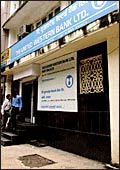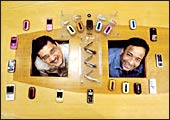 |
| UWB: In the eye of a storm |
There's
value everywhere these days, including in down and out banks.
You can't help, but get that feeling after seeing the queue of
banks that threw their hat into the ring for the ailing United
Western Bank (UWB). Last fortnight, the Reserve Bank of India
put the private sector bank under moratorium till December 1,
2006 in a bid to protect the interest of depositors. At the time
of writing, at least five banks, ICICI Bank, Federal Bank, Canara
Bank, Andhra Bank and Allahabad Bank had evinced interest in UWB.
ICICI Bank, which was quick off the blocks in showing interest
in the 70-year-old UWB, appears the most probable winner, reckon
analysts.
But why on earth would anybody want UWB,
you might well wonder. The Satara-headquartered bank, which had
deposits of Rs 6,480 crore against advances of Rs 4,006 crore
in 2005-06, had racked up losses of close to Rs 100 crore in each
of the past two financial years. The net non-performing assets
(NPAs) stand at 5.66 per cent, which compares poorly with its
peer group's figure of just 1.97 per cent. The bank's capital
adequacy ratio, too, turned negative at 0.3 per cent as on June
30, 2006 (the regulatory minimum is 9 per cent). "This has
jeopardised depositors' interest. The bank was also unable to
come up with any credible plan to raise fresh capital," notes
RBI in its moratorium notice.
Yet, ICICI and the clutch of other banks
sniffing around UWB have good reasons to do so. The bank has a
strong branch network of 230 branches in small towns, a dozen
extension counters and 75 ATMs (automated teller machines). At
a time when rural, and small & medium enterprise (SME) lending
is growing by leaps and bounds, acquiring UWB, infusing capital
in it and turning it around make ample sense. That UWB can access
low-cost funds in a progressive state like Maharashtra only enhances
its appeal.
In the meanwhile, as nervous depositors queued
up outside the bank branches to recover their money, the half-a-lakh
shareholders in UWB had to brave a stomach-churning crash in the
stock price (although some brave punters betting on a seamless
acquisition did somewhat salvage the stock). RBI may have slapped
the moratorium order ostensibly to protect depositor interest,
but there's little it can do to allow them (and investors) to
sleep better in the immediate term.
-Anand Adhikari
DLF's
IPO Blues
Minority shareholders spook a $3-billion
mega issue.
 |
| DLF Group's Chairman K.P. Singh: Facing
the realty? |
When
DLF ltd withdrew its draft herring prospectus in end-August, it
raised as many eyebrows as it did when it filed the document in
mid-May, when it planned to raise all of $3 billion (roughly Rs
14,100 crore) and a valuation of Rs 1,35,000 crore was bandied
about. The reason given by the company is that it had to update
the prospectus with the latest financial information. "The
updated prospectus will have the results from the September 30
quarter also. We expect to file the revised prospectus around
mid-October," says Saurabh Chawla, Senior Vice President
(Finance).
However, DLF's prospectus wasn't cleared
by the Securities and Exchange Board of India (SEBI) since LDF's
minority shareholders had complained to the regulator that they
were not allowed to participate in the company's rights issue
that took place in September 2005. Following this rights issue,
the holding of the promoters in DLF Ltd was up to 99.5 per cent.
Chawla says the matter is sub-judice and that his company had
put forth its point of view to the Ministry of Company Affairs.
"We are waiting for a decision from the ministry."
According to Chawla, DLF Ltd has added around
10-12 projects from the time the prospectus was first filed with
SEBI. "One of them is the development of the Dankuni township
in Kolkata, which will be over 5,000 acres of land," he says.
So, should we expect an even higher valuation the next time around?
-Krishna Gopalan
Diversifying
Into Disaster?
Rather than hedging risks, ONGC might
be raising them.
Over
the last few years, the Oil & Natural Gas Corporation (ONGC)
has been diversifying to hedge itself against the vagaries of
exploration and production. Petrochemicals, power and even special
economic zones (SEZs) have been some of those new ventures. But
how sound have been some of the decisions involving these new
businesses? Consider: ONGC has chosen to award contracts worth
Rs 700 crore for its petrochemical unit in the Dahej SEZ even
before signing up a fuel source. Implication: Doubling of the
fuel plant cost to around Rs 1,000 crore. Here's why: The main
petrochem unit will operate on hydrocarbon gases that are supplied
from an in-house 'extraction' plant that quite literally curdles
the 'rich' gas that is sourced from its supplier, Petronet LNG
Ltd (PLL). Only that it has yet to sign an extraction agreement
with PLL that takes back the 'lean' gas after the extraction process.
PLL has recently written to ONGc stating that it would require
to erect an additional tank (costing $100 million or Rs 470 crore)
to house 'rich' gas, since, into the future, it cannot assure
quality. ONGC is now revisiting the economics of the project-whether
to extract propane and butane (that go towards production of LPG
or liquefied petroleum gas) or settle for just the lower extracts
(that goes towards production of petrochemicals).
Another diversification that could turn sticky
is ONGC subsidiary Mangalore Refineries and Petrochemicals Ltd's
(MRPL) pitch to set up a 7.5-million-tonne refinery in Barmer,
Rajasthan, near Cairn Energy's oil find. The reason: The faulty
underlying assumptions that half the crude oil for the project
would be available for the life of the refinery at a charitable
$27 (Rs 1,269) per barrel!
R.S. Sharma, Chairman and Manging Director,
ONGC, maintains: "All diversifications will be pursued from
the point of view of viability. Nothing else."
-Balaji Chandramouli
Can Moto
Get Its Mojo Back?
Roti, kapda, makaan, Nokia, Samsung-and Motorola.
 |
| Motorola's Agarwal (left) and Mathias:
They've hit the market with a vengeance |
Back
in the mid-90s when the Indian telecom revolution was about to
take flight, Motorola was the undisputed King of the Hill with
dominant market shares in two-way radios and pagers. Even when
the mobile revolution began in late 90s, Motorola was a key handset
provider. Then, somewhere down the line, as Motorola globally
grappled with problems such as the botched Iridium satellite phone
project, it lost the plot in India (though it continued to be
on the ball in China).
Despite being one of the first American companies
to invest in an offshore technology centre in India back in 1991-an
investment that is reaping huge benefits for the company till
today-sales of consumer handsets have been abysmal. So much so
that by the end of the 2005-06 fiscal (according to data published
by CyberMedia) the company's sales actually shrunk, to Rs 507
crore from Rs 755 crore; market share touched rock bottom at 3.6
per cent, placing Motorola at a distant fifth in the market.
Sales might have been even worse had the
company not begun its slow but steady resurgence, which started
a year ago when Ed Zander, CEO, Motorola, visited India. Not only
did Zander make the company's Gurgaon office the regional headquarters
(looking after the subcontinent, South-East Asia, Africa and the
Middle East), his visit also precipitated a hiring spree. "95
per cent of the employees in this company have joined in the last
one year, many in the last six months," jokes Sudhir Agarwal,
Director Sales, Motorola India, who counts himself and his Marketing
counterpart Lloyd Mathias in that large number.
Currently, according to unofficial data,
the company has a market share of around 12-13 per cent in the
handset market (Motorola officials are cagey about figures, but
confirm that the company is back in double-digit territory) and
is vying with Samsung for the 'best of the rest' award, as Nokia
still dominates the market. According to Mathias, who was formerly
with PepsiCo India, the company has adopted several models to
get more and more consumers to purchase products. "When we
joined Motorola, there were almost no products in the market.
We had three models, including the razr which cost something like
Rs 40,000 then (it costs just Rs 9,000 now). We needed to beef
up our model line-up as well as get a better distribution strategy
in place," says the Director Marketing.
A tie-up with Bharti Teletech was inked that
made the Rakesh Mittal-run company a distributor for Motorola
products. "Overnight, the number of Motorola touch-points
(read: retail outlets) quadrupled," Mathias says. New models
were also brought into the line-up and prices of existing models
slashed; a basic Motorola razr now costs a quarter of its launch
price. More importantly, the company also aggressively began tying
up with operators.
"We have deals with most major operators",
Agarwal points out, and most of these are for entry-level handsets
in the sub-Rs 2,000 range. "This helps us because operators
have a massive reach. In up East, for example, whenever Hutch
expands its network, our C117 phone which is bundled with a Hutch
connection is integral to that expansion because even if 40 per
cent of their dealers sell our phone, that is a tremendous reach.
In Kerala, as Idea Cellular is rolling out further during Onam,
the C114 will play a critical role. So you have to realise that
market share is not all about razrs, SLVRs and PEBLs," Agarwal
points out. Motorola India is also expected to tie-up with state-owned
Bharat Sanchar Nigam Ltd (BSNL) for selling bundled phones as
the operator is about to roll out its massive new network.
In addition, Agarwal also mentions Motorola's
other major initiative, in rural India with tie-ups with DCM-Shriram
and ITC. "The Hariyali and e-Choupal markets in north India
and the N-logue markets in southern India will give us access
to thousands of villages. And in our research we realised that
these villagers wanted brand new phones, not repackaged second-hand
phones," adds Agarwal.
But the RAZRs, SLVRs and PEBLs do help, especially
in urban areas where churn rates are increasing. "It would
be fair to say that we have made these handsets fashion symbols,"
Mathias chuckles. "We've used Abhishek (Bachchan) quite well
as our brand ambassador and that has helped us tremendously. But
more importantly, we have tied up with GE Money and that allows
us to sell phones on monthly installments. No other phone manufacturer
does this."
Both Mathias and Agarwal realise that a few
good months don't make a summer, and catching up with the monster
that is Nokia will not be easy. But Motorola India Chairman Firdose
Vandrewala believes that even more exciting times are to come
for the company, "We have just started. Our objective isn't
to be just another multinational, we at Motorola India have to
make Motorola relevant to India and India to Motorola. We might
have improved our market presence and our devices on the market,
but we have to do more. The mantra of the future for us should
be Roti, kapda, makaan, mobile. We have to continue to focus on
connecting the unconnected."
-Kushan Mitra
|







